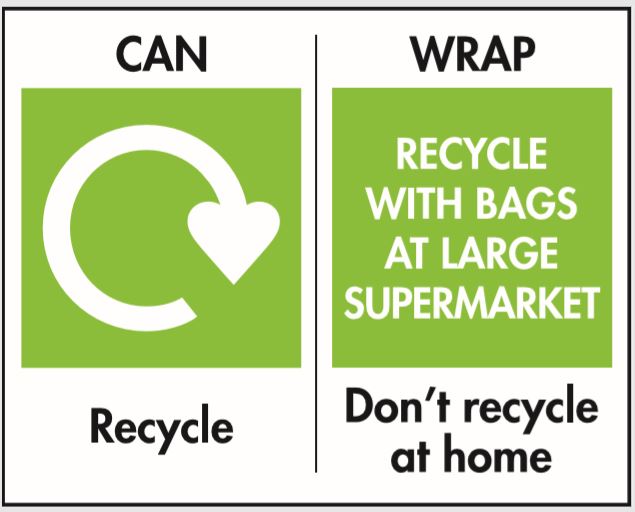The On-Pack Recycling Label (OPRL) has leapt to the defence of its simplified recycling label following concerns that the scheme could discourage recycling and increase contamination.
In December, the not-for profit body announced that it would be launching a new binary On-Pack Recycling Label this month (see letsrecycle.com story)

The OPRL says that special labels. such as this one for a multipack of cans, will be issued for certain packaging items under the new scheme
This will see hundreds of thousands of product lines in the UK featuring a simplified traffic-light system stating either ‘Recycle’ or ‘Don’t Recycle’.
To achieve the ‘Recycle’ mark, material must be collected by over 50% of councils, be able to be processed and have a market.
Under the previous system, packaging was divided into three subgroups: ‘widely recycled’ (collected by 75% or more of councils at the kerbside); ‘check local recycling’; and, ‘not currently recycled’ (collected by less than 20%).
Final details of this are being thrashed out and the scheme will officially launch by the end of January.
Concerns
However, concerns have been raised that while well intended, the new scheme may inadvertently see material which would otherwise be recycled being sent for disposal if it falls below the 50% collection bracket.
And, some have warned that the scheme could increase contamination in areas which do not accept materials which are commonly accepted elsewhere.
Anti-incineration campaigner, Schlomo Dowen, described the new system as “terrible”.
Mr Dowen, who is national co-ordinator of the UK Without Incineration Network (UKWIN), said: “It is not clear exactly how this is going to promote recycling. There are items which for example can be recycled by 45% of authorities which will be marked as not recyclable and will end up in the wrong bin.
He added: “There is a danger that local authorities will reduce rather than extend the range of material they collect based on this arbitrary system.”
This was disputed however by the OPRL, which said that there isn’t packaging which falls into the 45% category, and the system will make things easier for consumers to understand.
Mr Dowen said the OPRL was also refusing to make public a comprehensive list of what was classed recyclable and not under the new labelling scheme and had not consulted on its plans with the wider industry.
Newark & Sherwood
Phil Hadfield, environmental projects officer at Newark & Sherwood district council, also raised concerns that the new labelling scheme could increase contamination.
He explained that Newark & Sherwood does not currently collect plastic trays and other mixed plastics at the kerbside and was worried the new system would encourage residents to attempt this.
Mr Hadfield commented: “We have a problem with contamination generally and if people think they can put mixed trays in then our contamination rates will go up.”
“They are doing this three years too soon, before the government has realised its ambition to move towards consistent collections by 2023. They are saying yes and that does not work for us. A three year lag time would work perfectly.”
@OPRL ‘s new binary system launches 3 years too early. Until collection systems are consistent then this just increases pressure on Council’s who aren’t able to change to their input spec until after 2023 enforces it. “Widely” and “Check locally” left some room for education.
— Phil Hadfield (@HadfieldPhil) 7 January 2020
System
Responding to these concerns, OPRL chair Jane Bevis told letsrecycle.com that the new system was not that different from the old one and simply removed the ‘check local recycling’ category which she said had proved confusing for consumers.
Commenting on the risk of impacting recycling or increasing contamination, she said: “We think it is a very small risk. We did speak to LARAC (the Local Authority Recycling Advisory Committee) about this.
“The LARAC Executive looked at the risks and said they were happy with the approach we are taking. We are still launching a recycling app which will tell you exactly what you can recycle and when and which bin to pit it in.”
“There is already a lot of consistency in council collections so we don’t think we are jumping the gun too much”
Ms Bevis added that no materials would be brought into the ‘not recycled’ category which were not there previously and that, by and large, most materials were very commonly collected for recycling at the kerbside (collected by 80% of councils or more) or very rarely collected (20% or fewer), rather than somewhere in the middle.
And, she said that ‘special labels’ would be issued for materials for which there was an alternative, nationwide collection infrastructure in place.
For instance, PE film will feature a label saying that it can be taken to larger stores for recycling and the label on beverage cartons will say that they can be taken to local recycling points and to check kerbside collections.
Labelling
Explaining why the new label had been launched so early, Ms Bevis said that businesses wanted to prepare for upcoming legislation on collection consistency and that it took 3-4 years for new labelling systems to bed in, as companies reviewed their packaging.
She added: “There is already a lot of consistency in council collections so we don’t think we are jumping the gun too much.”
Launch
Ms Bevis explained that preparations for the official launch of the new labelling system were progressing well.
She said: “We are frantically working on finalising the art work at the moment. It will be finished by the end of this month – next week or the week after.
“There will be detailed guidance with lists of what can and cannot be recycled – but we only give that to people if they are members. We will make public the source of evidence we use.”
The post OPRL plays down ‘risks’ of new label appeared first on letsrecycle.com.
Source: letsrecycle.com Packaging



